

Vol. 41 (Issue 08) Year 2020. Page 27
BOGDANOVA , Elena N. 1; LOBANOV , Andrey A. 2; ANDRONOV , Sergey V. 3; POPOV , Andrey I. 4; KOCHKIN , Ruslan A. 5 & MORELL ASZTALOS, I. 6
Received: 09/11/2019 • Approved: 03/03/2020 • Published 12/03/2020
ABSTRACT: The article presents the demographic “portrait” of the Tazovskaya, Gydanskaya and Nakhodkinskaya tundras in Western Siberia. The study is focused on the analysis of “gender shift” in a nomadic family of the Tazovsky district in the Yamal-Nenets autonomous okrug. We implemented quasi-genetic methods, cluster and gender analysis to explore marriage bonds and the Arctic indigenous peoples’ clan structure (“erkars” and “tenzes”). The research was conducted with the support of the Russian Foundation for Basic Research (project No. 18-010-00875). |
RESUMEN: El artículo presenta el "retrato" demográfico de las tundras Tazovskaya, Gydanskaya y Nakhodkinskaya en Siberia occidental. El estudio se centra en el análisis del "cambio de género" en una familia nómada del distrito de Tazovsky en el okrug autónomo Yamal-Nenets. Implementamos métodos cuasi-genéticos, análisis de grupos y de género para explorar los lazos matrimoniales y la estructura de clanes de los pueblos indígenas del Ártico ("erkars" y "tenzes"). La investigación se realizó con el apoyo de la Fundación Rusa para la Investigación Básica (proyecto No. 18-010-00875). |
The history of the population in the Polar territories of Western Siberia dates back several thousand years. However, most of the Nenets families migrated to the Arctic and subarctic zone of the Yamal only in the 17th century. At the same period, Khants and Selkups moved to the North from the Priob'ye (the areas along the Ob river in the Khanty-Mansyisky district of Western Siberia). Later, other people of the Yamal migrated to the High North: Russians – in the 17th century, Zyryans – in the second half of the 19th century. So, most of the indigenous population of the Yamal are not so long-standing migrants. For natural selection and genetic adaptation, a period of 100-500 years is negligible with a small number of population and limited genetic exchange (Lobanov, A.A. et al. 2012).
This complex process of the indigenous population’s formation in Western Siberia was highlighted in the works by M.G. Levin, L.P. Potapov (1956), L.V. Khomich (1966, 1995), N.A. Minenko (1975), A.V. Golovnev (1989, 1997, 1999, 2015, 2016), V.I. Vasiliev (1994), S.V. Lezov (2000), J.O. Habeck (2005), F. Ackerman, T. Salminen (2006), B. Donahoe, J.O. Habeck, A. et al. (2008), E.V. Liarskaya (2009), E.A. Volzhanin (2011), T. Heleniak, T. Holzlehner, E. Khlinovskaya (2011), Yu.N. Kvashnin (2012), G.V. Vizgalov, A.V. Kardash, R.A. Kosintsev (2013), G.G. Kornilov, G.E. Kornilov, N.A. Mikhalev, A.G. Orudzhiev (2013), R. Laptander (2014, 2017), Y. Atsusi (2014), A.N. Bagashev, S.M. Slepchenko (2015), D.A. Oparin (2016, 2018) etc. During later periods the Northern population of Western Siberia was formed mainly due to migration from the European part of Russia, southern Siberia and former Soviet republics (Oparin, Dmitriy A. 2016).
Currently, there are the positive demographic trends of the minor indigenous peoples in the Russian High North, including Western Siberia. In 2010 compared to 1989, according to the data of All-Russian census, the population of Nenets (29,772 / 19,639 people) and Khants (9,489 / 6,281 people) increased 1.5 times, the number of Selkups – by 15% (1 988 / 1 561 people). That was the result of the initiating new governmental programs to support the indigenous peoples in the Russian North (The Decree of the Government of the Russian Federation, 04.02.2009, No. 132-r “On the Concept of Sustainable Development of the Indigenous Peoples of the North, Siberia and the Far East of the Russian Federation”). During the last 20 years, three federal targeted programs on the sustainable socio-economic development of the minor Northern indigenous peoples have been implemented in the Russian Federation, as well as several regional targeted programs and subprograms, to support reindeer husbandry and livestock breeding.
However, currently, in Russia, there is a problem of statistical monitoring the number of indigenous people. In 1996-2009, governmental statistics bodies of the Russian Federation carried out federal statistical monitoring of the socio-economic situation in the indigenous communities of the North, following the decrees, approved by the Government of the Russian Federation (No. 22, 11 January 1993; No. 99, 7 October 1993; No. 58, 23 January 2000). However, the Decree of the Government of the Russian Federation No. 410 of 8 May 2009 cancelled these documents. Only much later, the Strategy for the Development of the Arctic Zone of the Russian Federation and National Security for the Period up to 2020, approved by the President of the Russian Federation, declared the need for organizing a reliable statistical monitoring of the socio-economic situation and transition processes of the traditional lifestyle and economic activities in the indigenous communities of the North, Siberia and the Far East of the Russian Federation. Strategic initiatives are focused on monitoring a macroeconomic indicator "an increase in the life expectancy of Indigenous peoples of the North, Siberia and Far East of the Russian Federation living on the territory of the Russian Arctic." (Strategy… 2008). It should characterize the level of socio-economic development of this population and the national security of the Arctic zone in the Russian Federation.
The demographic “portrait” of Western Siberia can be “created” by studying the problems of close relatives’ marriages among the indigenous peoples of the Yamal and the risk-factors of their traditional lifestyle transformation. This paper aimed to analyze the marriage bonds of the Nenets living in the Tazovsky district of the Yamal-Nenets autonomous okrug (YNAO), which still retains many features of the traditional ‘clan’ structure and creates unique opportunities for studying their ethnogenesis since it allows to use research methods practically inapplicable in the urban society.
The characteristics of the Nenets was given by L.V. Khomich (1995), who noted the following features of their ‘family structure’: exogamy (marriages within a clan are strictly prohibited), male’s dominance in a family, the existence of a special territory, patrimonial sacrificial places and cemeteries, collective production and distribution methods of running household, the custom of patrimonial mutual help, the importance of patrimonial names, levirate, and the authority of the elderly people. A ‘clan’ determined the life of a family and its members’ religious beliefs and customs: it was a military organization in clashes with neighbours (Khlomich, L.V. 1995).
The methodology of the article is based on a multidisciplinary approach and the implementation of the methods of Sociology, Economics, and Medicine, including quasigenetic methods. Primary resources of the study were the data collected by interviewing 264 indigenous people (Nenets) during the expeditions to the Tazovskaya, Gydanskaya and Nakhodkinskaya tundras in the Tazovsky district of the Yamal-Nenets autonomous okrug in summer (August) and winter periods (March, November) of 2017-18 (figure 1). The fieldwork was provided by the researchers of the Arctic Scientific Research Center of the YNAO.
Figure 1
The territory of the Tazovsky district of the
Yamal-Nenets autonomous okrug, Western Siberia
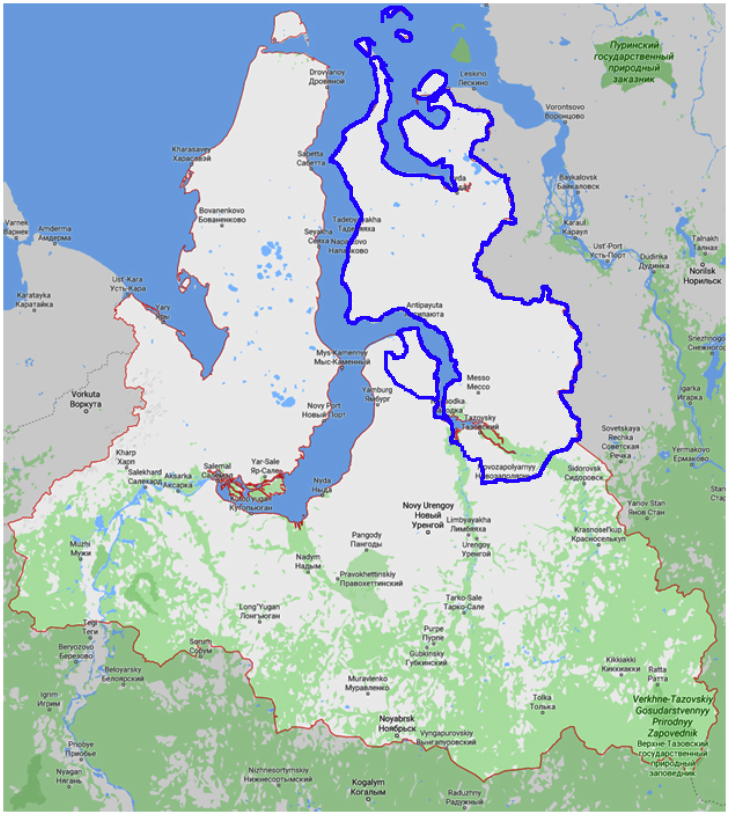
(Retrieved from: https://www.google.com/maps/; edited by Bogdanova, Elena N.)
Semi-structured interviews were based on the interview guide developed and approved by the Arctic Scientific Research Center of the Yamal-Nenets Autonomous Okrug. The data were obtained about 2973 ancestors and descendants of the respondents. So, the information of three generations of the Nenets living in the Tazovskaya, Gydanskaya and Nakhodkinskaya tundras were summarized (n=3237). The data were included in a database and analyzed using the STATISTICA 6. To assess the significance of differences between the groups, the χ-square criterion was used (for qualitative variables). To process the data on the frequency of marriages and division into groups, cluster analysis was implemented.
The selection criteria for the respondents were: Nenets origin (at least one of the parents had a Nenets origin, Nenets-speaker), traditional lifestyle (mostly nomadic or semi-nomadic), including into the medical examinations provided by the researchers of the Arctic Scientific Research Center of the YNAO. Every participant of the study (over 18 years old) filled in an informed consent form. The personal data of the participants were included in the databases of the project team of the Northern Arctic Federal University, anonymized and numbered.
The use of surnames (‘generic names’) as a quasigenetic marker is relevant in solving genetic ‘puzzles’. In most cases, surnames, transmitted along the male line, are an analogue of the Y-chromosome, according to the transmission method. Surnames are an available resource, that makes them attractive for quasigenetic studies, provides higher coverage of a study population; it provides the representativeness of the sample and increases the reliability of the results (Balanovskaya, E.V. et al. 2005; Sorokina, I.N. et al., Part II, 2007); finally, it allows to assess the differentiation of a gene pool (Sorokina, I.N. et al., Part I, 2007).
Equal representation of men and women with the same surname was assumed; to avoid mistakes caused by the lack of this equality (change of surname after marriage), the analysis of marriage bonds was conducted. Marriages of close relatives were considered to be extremely rare. However, in the indigenous communities and small remote settlements they were not so rare, that could result in genetic mutations (Inherited diseases… 2002; Sorokina, I.N. et al. 2010).
Many authors highlighted a "clan structure" of the Nenets’ traditional society, which experienced an important impact of the migration processes: from the 17th up to the middle of the 20th centuries, a Nenets’ family and tribal ‘composition’ was formed from the representatives of the Nenets, Khants and Komi clans. However, Nenets mostly use the words of "an erkar" (a family) or "a tenz" (a phratry (Vasiliev, V.I. 1994; Vershinin, E.V. 2000; Martynova, E.P. 1998)) to define a clan. In our paper, we used this terminology to be clear in terms and address correctly the specifics of the traditional Nenets culture.
The implementation of a cluster analysis allowed us to divide a study population into three groups (tenzes). There were no gender and age differences between the identified groups (HK-W = 1.8; p = 0.4). The tenz ‘Yar-Salinder’ included 73 families, ‘Yadne-Yaptunay’ – 82, ‘Vengo-Lapsui’ – 63 (table 1).
Table 1
The study population of the Tazovskaya, Gydanskaya and Nakhodkinskaya
tundras of the Yamal-Nenets autonomous okrug divided into three tenzes
Tenz 1 |
Tenz 2 |
Tenz 3 |
|||
Structure |
Distance |
Structure |
Distance |
Structure |
Distance |
erkar ‘Salinder’ |
2.98 |
erkar ‘Yadne’ |
2.66 |
erkar ‘Vengo’ |
0.7 |
erkar ‘Yar’ |
2.98 |
erkar ‘Evai’ |
0.97 |
erkar ‘Lapsui’ |
0.7 |
|
erkar ‘Tesida’ |
1.49 |
erkar ‘Tibichi’ |
0.7 |
|
|
|
erkar ‘Yando’ |
1.95 |
|
|
|
|
erkar ‘Yaptunay’ |
2.7 |
|
|
|
|
Russian |
1.9 |
|
|
Table 1. Authors' elaboration
The analysis of the indigenous population’ marital composition in the settlements Tazovsky and Gyda (figure 2) revealed that the inter-erkars marriages ‘Yar-Yaptunay’ and ‘Salinder-Yadne’ were the most frequent.
Figure 2
The results of the cluster analysis of the marriage
bonds in the settlements Tazovsky and Gyda (n=1121)
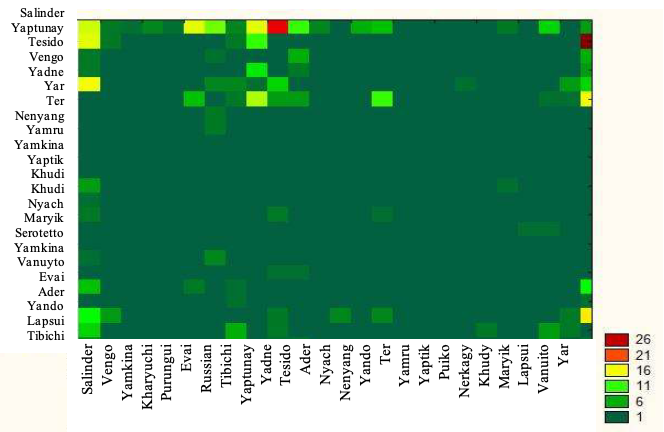
Authors' elaboration
In the settlement Gyda the marriage bonds between the erkars ‘Yar’ and ‘Yaptunay’ prevailed (figure 3).
Figure 3
The results of the cluster analysis of the marriage
bonds in the settlement Gyda (n=418)
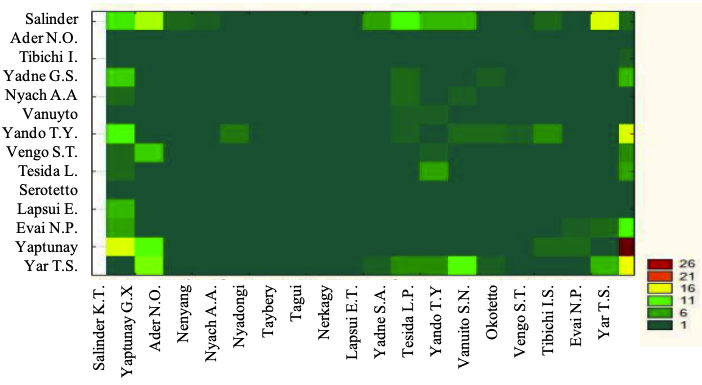
In the settlement Tazovsky two prevailing combinations of marriage bonds were identified: ‘Yar-Salinder’ and ‘Yar-Russian’ (figure 4). Authors' elaboration
Figure 4
The results of the cluster analysis of the marriage
bonds in the settlement Tazovsky (n=452)
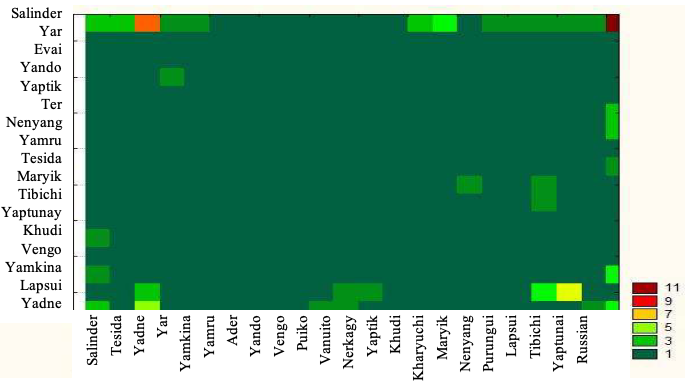
Authors' elaboration
The part of the population in Tazovsky district lives in the tundra. So, the residents of the Gydanskaya and Nakhodkinskaya tundras were also included in the study. Inter-erkar marriage bonds of ‘Salinder-Khudi’ and ‘Salinder-Yadne’ were identified as the most frequent (figure 5).
Figure 5
The results of the cluster analysis of the marriage bonds in
the Gydanskaya and Nakhodkinskaya tundras (n=110)
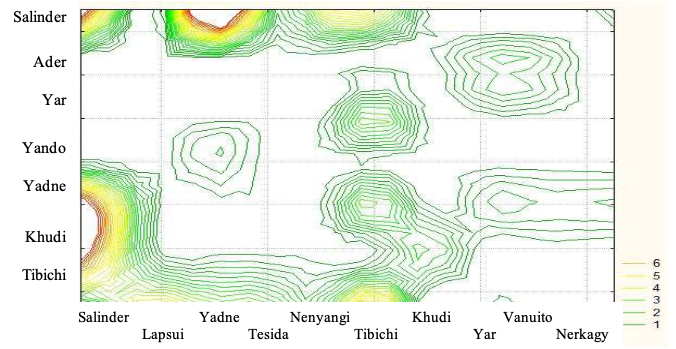
Authors' elaboration
The analysis of Nenets-Russian marriages in the settlements Tazovsky and Gyda (n=1121) revealed that the frequency of marriage bonds ‘a Russian husband-a Nenets wife’ has increased to the third generation (c2 – 6,7; p=0.009): I generation – 1.3%, II – 2.6%, III – 4.8%. The analysis of marriage bonds during three generations proved the sustainable prevalence of ‘Yaptunay-Yar’ inter-erkar marriages. So, it allows resuming that a new tenz has formed. The increasing frequency of ‘Nenets-Russian’ marriages in the third (present) generation is also of great interest (figure 6).
When analyzing the structure of marriages between Nenets and Russians in the settlements Tazovsky and Gyda proved the most frequent type of ‘a Russian husband-a Nenets wife’ (χ2 – 4.0; p = 0.05). In total, 33 cases of close relatives’ marriages were revealed, including 3.1% of the incidents among the interviwed population in the Gydanskaya tundra (n=25), 4.5% – in the Nakhodkinskaya tundra, 2.9% – in the Tazovskaya tundra.
Figure 6
The results of the cluster analysis of the marriage bonds in the
settlements Tazovsky and Gyda during three generations (n=1121).
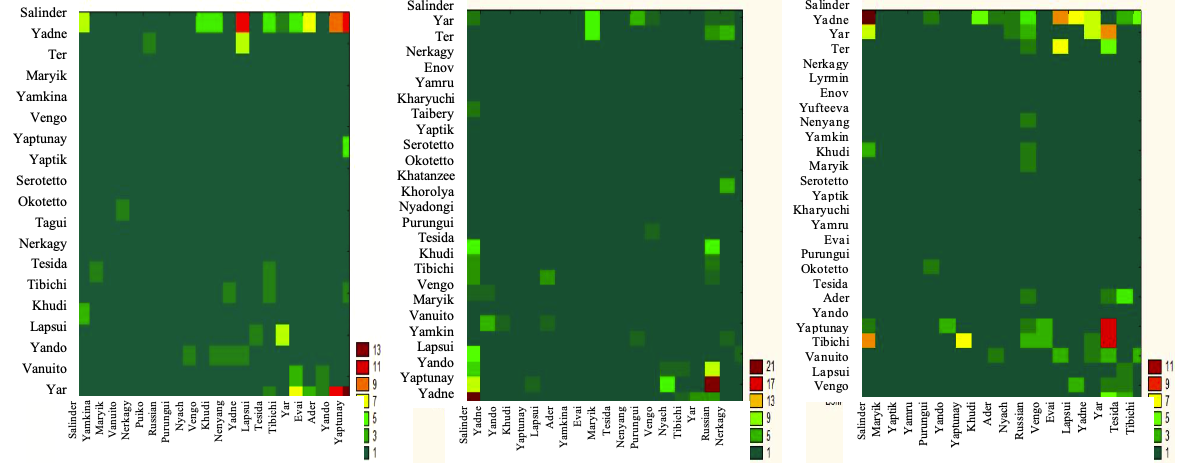
Authors' elaboration
In the official documents, generic names are often used as surnames. The representatives of both phratries (‘Kharyuchi’ and ‘Vanuito’) live on the Gydansky Peninsula and in the lower reaches of the Taz river [8]. There were several erkars which belong to the phratry ‘Kharyuchi’: ‘Ader’, ‘Evai’, ‘Lapsui’, ‘Nanyang’, ‘Nyaruy’, ‘Okotetto’, ‘Susoy’, ‘Serotetgo’, ‘Syugnei’, ‘Toga’, ‘Teshida’, ‘Habdyu’, ‘Kharyuchi’, ‘Khudi’, ‘Hano’, ‘Yadne’, ‘Yando’ and ‘Yaptunay’. The phratry ‘Vanuito’ is represented by the following erkars: ‘Aseda’, ‘Vanuito’, ‘Wengo’, ‘Veho’, ‘Lamdo’, ‘Maryik’, ‘Nerkagy’, ‘Nyadongi’, ‘Okovai’, ‘Parovy’, ‘Puiko’, ‘Purungui’, ‘Saba’, ‘Salinder’, ‘Ter’, ‘Tibichi’, ‘Yaptik’, ‘Yar’ and ‘Yaungad’ (Martynova, E.P. 1998). Currently, the features of the old phratries ‘Kharyuchi’ and ‘Vanuito’ are still being preserved. However, the formation of a new phratry ‘Yar-Yaptunai-Salinder’, based on various "old phratries", has been noticed.
Our study showed that the ethnogenesis of the Nenets has not stopped yet, but it is moving into a new phase. The preservation of the Nenets’ generic structure gives a unique opportunity for studying ethnogenesis not only by descriptive methods of ethnology but also using the mathematical apparatus. These studies provide a large amount of information not only to ethnologists, anthropologists, economists and historians but also to doctors, specialists in genetics and epidemiology.
The current trends in family formation in the young generation are largely due to the “gender shift” in the tundra, mentioned by many researchers (Khomich, L.V. 1950, 1989; Liarskaya, E. 2010; Serpivo, S.E. 2016, etc.), that’s also the result of the impact of globalization processes (Ravna, Z.V. 2018).
In the youngest generation, there is a significant increase in the frequency of marriages between Russians and Nenets, caused by closer contacts in the settlements during the studying period, getting a close education level, and working together. However, there is an evident disproportion. The marriages of ‘a Russian husband-a Nenets wife’ prevailed. This is due to the easier adaptation of Nenets women in a settlement.
Nenets women, as a rule, have a higher level of education than men, perform qualified work, prefer easier and more comfortable living conditions in the settlement to the harsh conditions of nomadic life. Therefore, they are more likely to move to urban areas than men (Liarskaya, E.V. 2016). And this correlates with the trend in the Scandinavia (Adolfsson, E. 2016; Dahlström, M. 1996; Leibert, T. 2016). Women often encourage their children to get a higher education and want them to enjoy the benefits of civilization. These factors often contribute to the preference for marriages with Russian men, but not with Nenets living in the tundra. Russian men choose Nenets women because of traditional relationships typical for Nenets families, especially domination and respect for men. In addition, V. Skvirskaja noted that Russian men are ready for romantic relationships in comparison with the Nenets, who are more pragmatic (Skvirskaja, V. 2018).
On the other hand, Nenets men are more difficult to adapt in the settlement, less likely to get an education and low-qualified jobs, more often have problems with alcohol when moving to the settlement. Finally, the status of a reindeer herder is especially important for men. It makes them consider the traditional lifestyle to be more attractive and prefer to stay in the tundra.
The analysis of marriage bonds during three generations revealed a prevailing of inter-erkar marriages ‘Yaptunay-Yar’, which allows declaring the formation of a new tenz. The frequency of close relatives’ marriages among the Nenets in different groups was different, but it didn’t exceed 5.0%. In the third (youngest) generation, there was a significant increase in the frequency of marriage bonds of the Nenets and Russians. The marriages of ‘a Russian husband-a Nenets wife’ dominated.
As a result of the current demographic processes in the tundra, there is a situation of “shortage” of brides who are ready to run a traditional lifestyle. Thus, currently, men are its “keepers”, while women prefer to follow urban trends.
The research was conducted with the support of the Russian Foundation for Basic Research (project 18-010-00875)
Ackerman, F; Salminen, T. (2006) Nenets. Encyclopedia of language and linguistics. Boston, USA, Elsevier. Volume 1, pp. 577-579.
Adolfsson, E. (2016) Fler män än kvinnor? En studie av könsobalans bland unga vuxna i Sveriges kommuner / Örebro universitet HumUS-institutionen Kulturgeografi. PhD theses. Retrieved from: http://www.diva-portal.org/smash/get/diva2:936225/FULLTEXT01.pdf.
Atsusi, Yoshida (2014) Taz Nenets – Ethnic History. Studies on the culture of the Nenets: Collection of articles. St. Petersburg, Historical Illustration,pp. 113-129.
Bagashev, A.N., and Slepchenko, S.M. (2015) Materials of craniology of Taz Nenets. Materials of III All-Russian Conference “Man and the North”: anthropology, archeology, ecology. Tyumen, pp. 6-10.
Balanovskaya, E.V., and Solovieva, D.S., Balanovsky, O.P. et al. (2005) “Family portraits” of five Russian regions. Medical genetics. No. 1, pp. 2-10.
Dahlström, M. (1996) Young women in a male periphery – experiences from the Scandinavian North.Journal of rural studies, Volume 12, Issue 3, pp. 259-271. DOI: https://doi.org/10.1016/0743-0167(96)00018-6.
Donahoe, Brian, and Habeck, Joachim Otto, Halemba, Agnieszka, et al. (2008)Size and place in the construction of indigeneity in the Russian Federation. Current anthropology, December, Volume 49, Issue 6, pp. 993-1020.
Golovnev, A.V. (1989) On the history of Nenets reindeer husbandry. Cultural traditions of the peoples of Western Siberia. Novosibirsk, NGPI, pp. 94-108.
Golovnev, A.V. (1997) Nenets: reindeer herders and hunters. The peoples of Siberia: rights and opportunities. Novosibirsk, SB RAS, pp. 80-90.
Golovnev, A.V., and Osherenko, G. (1999) Siberian survival: the Nenets and their story. Ithaca and London, Cornell University Press, 176 p.
Golovnev, A.V., and Perevalova, E.V., Abramov, I.V. et al. (2015) Arctic nomads: text-visual miniatures. Ekaterinburg, Alpha-print, 132 p.
Golovnev, Andrei, V. (2016) Yamal Nomads: facing risks and maneuvering. Siberian historical research-Sibirskie istoricheskie issledovaniya, December, Issue 4, pp. 154-171. DOI: 10.17223/2312461X/14/8.
Habeck, J.O. (2005) Dimensions of identity. Rebuilding identities. Pathways to reform in post-soviet Siberia. Berlin, Dietrich Reimer Verlag, pp. 9-26.
Heleniak, T., and Holzlehner, T., Khlinovskaya, E. (2011)The great exodus demographic trends on Russia's Northern periphery. Osteuropa, Feb-Mar, Volume 61, Issue 2-3, p. 371.
Inherited diseases in human populations (2002). Ed. by E.K. Ginter. Moscow, Medicine, 302 p.
Khomich, L.V. (1950) Nenets woman before and after the Great October Socialist Revolution. Dissertation. Moscow, 200 p.
Khomich, L.V. (1966) Nenets: Historical and ethnographic essays. Moscow-Leningrad, Science, 339 p.
Khomich, L.V. (1989) Nenets marriage and family: tradition and modernity. Materials of the VI International Congress of Finno-Ugric Studies. Moscow, pp. 237-238.
Khomich, L.V. (1995) Nenets. Essays on a traditional culture. St. Petersburg, p. 157.
Kornilov, G.G., and Kornilov, G.E., Mikhalev, N.A., Orudzhieva, A.G. (2013) The population of the Yamal in the XX century: historical and demographic analysis. Ekaterinburg, Publishing house of AMB, 360 p.
Kvashnin, Yu.N. (2012) Ethnic and demographic processes in the Taz Nenets at the beginning of the XXI century. Bulletin of Archeology, Anthropology and Ethnography. Issue. 3, pp. 141-152.
Laptander, R. (2014) Processes of remembering and forgetting tundra Nenets' reminiscences of the 1943 Mandalada Rebellions. Sibirica-interdisciplinary journal of Siberian studies, Volume 13, Issue 3, pp. 22-44.
Laptander, R. (2017) Collective and individual memories: narrations about the transformations in the Nenets society. Arctic anthropology, Jan, Volume 54, Issue 1, pp. 22-31. DOI: 10.3368/aa.54.1.22.
Leibert, T. (2016) She leaves, he stays? Sex-selective migration in rural East Germany. Journal of rural studies, February, Volume 43, pp. 267-279. DOI: https://doi.org/10.1016/j.jrurstud.2015.06.004.
Levin, M.G., and Potapov, L.P. (1956) The peoples of Siberia. M.-L., Publishing House of the Academy of Sciences, 1082 p.
Lezov, S.V. (2000) Siberian Nenets (Samoyeds) in the middle of the XIX century: a dialogue of nomads and officials. Antiquities of Yamal. Ekaterinburg-Salekhard, Ural Branch of the Russian Academy of Sciences, pp. 191-208.
Liarskaya, E. (2010) Women and the tundra: a gender shift in the Yamal? Anthropological forum. Issue 13, pp. 3-37.
Liarskaya, E.V. (2016) Someone also needs to live in the city: some features of the transformation of the social structure of the Nenets of the Yamal. Ethnographic Review. Issue 1, pp. 54-70.
Liarskaya, Elena V. (2009) Settlement Nenets on the Yamal peninsula: who are they?Folklore-electronic journal of folklore, Issue 41, pp. 33-46.
Lobanov, A.A., and Andronov, S.V., Popov, A.I., Kochkin, R.A., Tolstova, E.A., Kabanova, E.V., Lobanova, L.P. (2012) Person. Lungs. High North. Nadym, 176 p.
Martynova, E.P. (1998) Essays on the history and culture of the Khanty. Moscow. 235 p.
Minenko, N.A. (1975) Northwest Siberia in the 18th – first half of the 19th centuries. Historical and ethnographic essay. Novosibirsk, Science, 308 p.
Oparin, Dmitriy A. (2016) 'Locals' and 'newcomers' in the Yamal. Social boundaries and variations of the migration experience. Siberian historical research-Sibirskie istoricheskie issledovaniya, December, Issue 4, pp. 108-130. DOI: 10.17223/2312461X/14/6.
Oparin, Dmitriy A. (2018) Locals and immigrants on the Yamal peninsula. Social boundaries and variations in migratory experience. Asian ethnicity, Volume 19, Issue 2, pp. 251-269. DOI: 10.1080/14631369.2017.1386543.
Ravna, Z.V. (2018) The nomadic Nenets dwelling "Mya": the symbolism of a woman's role and space in a changing tundra. Alternative-an international journal of indigenous peoples, Mar, Volume 14, Issue 1, pp. 2-12.
Serpivo, S.E. (2016) Female space in the Nenets culture. Saint-Petersburg, Historical illustration, 152 p.
Skvirskaja, V. (2018) Native marriage "Soviet" and "Russian" style. The political economy of desire and competing matrimonial emotions. Sibirica-interdisciplinary journal of Siberian studies, Jun, Volume 17, Issue 2, pp. 41-59.
Sorokina I.N., and Churnosov, M.I., Balanovskaya, E.V. (2007) The gene pool of the population of the Belgorod region. Part I Differentiation of all district populations according to anthroponymy. Genetics. Vol. 43, No. 6, pp. 841-849.
Sorokina, I.N., and Churnosov, M.I., Balanovskaya, E.V. (2007) The gene pool of the population of the Belgorod region. Part II “Family portraits” in groups of districts with different levels of subdivision and the role of migrations in their formation. Genetics. Vol. 43, No. 8, pp. 1120-1128.
Sorokina, I.N., and Lependina I.N., Rudykh N.A., Verzilina A.V., Churnosov M.I. (2010) Surnames as quasigenetic markers in population genetic studies. Scientific statements of BelSU. Series “Medicine”. “Pharmacy”. No. 22, Vol. 12, pp. 72-79.
The Strategy for the Development of the Arctic Zone of the Russian Federation and National Security up to 2020, approved by the President of the Russian Federation on September 18, 2008. Retrieved from: http://www.consultant.ru/document/cons_doc_LAW_142561/.
Vasiliev, V.I. (1994) Nenets. Enets. Peoples of Siberia and the North of Russia in the 19th century (ethnographic characteristic). Moscow, pp. 29-75.
Vershinin, E.V. (2000) Nadym Town in the XVII century and the Russian development of North-West Siberia (based on written sources). Russian old-timers. Materials of the 3d Sib. Symp. Tobolsk; Omsk, pp. 28-31.
Vizgalov, G.V., and Kardash, A.V., Kosintsev, R.A. et al. (2013) Historical ecology of the population of the North of Western Siberia. Ekaterinburg, AMV, 376 p.
Volzhanina, E.A. (2011) The interpretation of Nenets demography in the first third of the twentieth century. The polar census and the architecture of enumeration. New York-Oxford, Berghahn Books, pp. 67-97.
1. Associate Professor, Ph.D. in Economics, Ph.D. in Phil. Department of Economics and Management. Northern Arctic Federal University, Arkhangelsk, Russia. Contact e-mail: elena.bogdanova@gmail.com
2. Leading researcher, Doctor of Science (Medicine). National Medical Research Center for Rehabilitation and Balneology, Ministry of Health of the Russia, Moscow, Russia. Contact e-mail: alobanov89@gmail.com
3. Senior researcher, Senior researcher. Arctic Research Scientific Centre, Nadym, Russia. Contact e-mail: sergius198010@mail.ru
4. Head of the Medical Sector, Ph.D. in Medicine. Arctic Research Scientific Centre, Nadym, Russia. Contact e-mail: anpopov2007@yandex.ru
5. Senior researcher. Arctic Research Scientific Centre, Nadym, Russia. Contact e-mail: kochkin25011983@mail.ru
6. Associate Professor, Ph.D. in Sociology. Swedish University of Agricultural Sciences (SLU), Uppsala, Sweden. Contact e-mail: ildiko.asztalos.morell@slu.se
[Index]
revistaespacios.com

This work is under a Creative Commons Attribution-
NonCommercial 4.0 International License